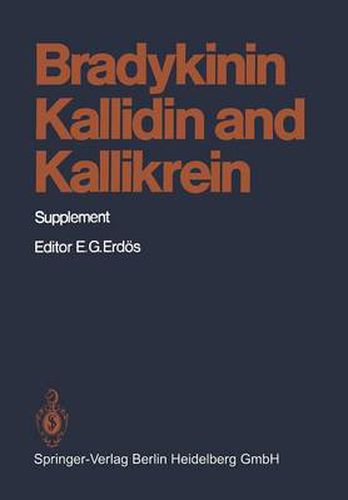Readings Newsletter
Become a Readings Member to make your shopping experience even easier.
Sign in or sign up for free!
You’re not far away from qualifying for FREE standard shipping within Australia
You’ve qualified for FREE standard shipping within Australia
The cart is loading…






This title is printed to order. This book may have been self-published. If so, we cannot guarantee the quality of the content. In the main most books will have gone through the editing process however some may not. We therefore suggest that you be aware of this before ordering this book. If in doubt check either the author or publisher’s details as we are unable to accept any returns unless they are faulty. Please contact us if you have any questions.
Volume XXV of the Handbook of Experimental Pharmacology series entitled Bradykinin, Kallidin, and Kallikrein was published in 1970. My aim in editing this volume of the series is not to replace, but to update the 1970 edition. During the decade preceding the publication of Vol. XXV, the existence of kinins and kallikreins gained acceptance, the protein components of the system were purified and characterized and the peptides were synthesized. Even after these accomplish ments, interest in the subject has not abated, but has increased substantially. We have learned a great deal about the role that components of the kallikrein-kinin system play in other systems and about the immensely complex and intricate inter actions in blood. Directly or indirectly, kallikrein and kinins affect the coagulation of blood, the activation of complement, and the generation of angiotensin. Kinins release or modulate the actions of other agents, including prostaglandins, histamine, and catecholamines. Inhibitors of kallikrein or kininase II are employed, for example, in extracorporeal circulation or in hypertension. Kallikrein, kinins, and kininases, present in urine, were described first in 1925 and 1954, but have been ignored for decades. These substances are now studied extensively because of their possible role in blood pressure regulation. The evidence that kinins have a metabolic function is also increasing. The abundance of active components of the system in genital organs suggests a role in the fertilization process. The book is organized into chapters which bear upon these issues.
$9.00 standard shipping within Australia
FREE standard shipping within Australia for orders over $100.00
Express & International shipping calculated at checkout
Stock availability can be subject to change without notice. We recommend calling the shop or contacting our online team to check availability of low stock items. Please see our Shopping Online page for more details.
This title is printed to order. This book may have been self-published. If so, we cannot guarantee the quality of the content. In the main most books will have gone through the editing process however some may not. We therefore suggest that you be aware of this before ordering this book. If in doubt check either the author or publisher’s details as we are unable to accept any returns unless they are faulty. Please contact us if you have any questions.
Volume XXV of the Handbook of Experimental Pharmacology series entitled Bradykinin, Kallidin, and Kallikrein was published in 1970. My aim in editing this volume of the series is not to replace, but to update the 1970 edition. During the decade preceding the publication of Vol. XXV, the existence of kinins and kallikreins gained acceptance, the protein components of the system were purified and characterized and the peptides were synthesized. Even after these accomplish ments, interest in the subject has not abated, but has increased substantially. We have learned a great deal about the role that components of the kallikrein-kinin system play in other systems and about the immensely complex and intricate inter actions in blood. Directly or indirectly, kallikrein and kinins affect the coagulation of blood, the activation of complement, and the generation of angiotensin. Kinins release or modulate the actions of other agents, including prostaglandins, histamine, and catecholamines. Inhibitors of kallikrein or kininase II are employed, for example, in extracorporeal circulation or in hypertension. Kallikrein, kinins, and kininases, present in urine, were described first in 1925 and 1954, but have been ignored for decades. These substances are now studied extensively because of their possible role in blood pressure regulation. The evidence that kinins have a metabolic function is also increasing. The abundance of active components of the system in genital organs suggests a role in the fertilization process. The book is organized into chapters which bear upon these issues.